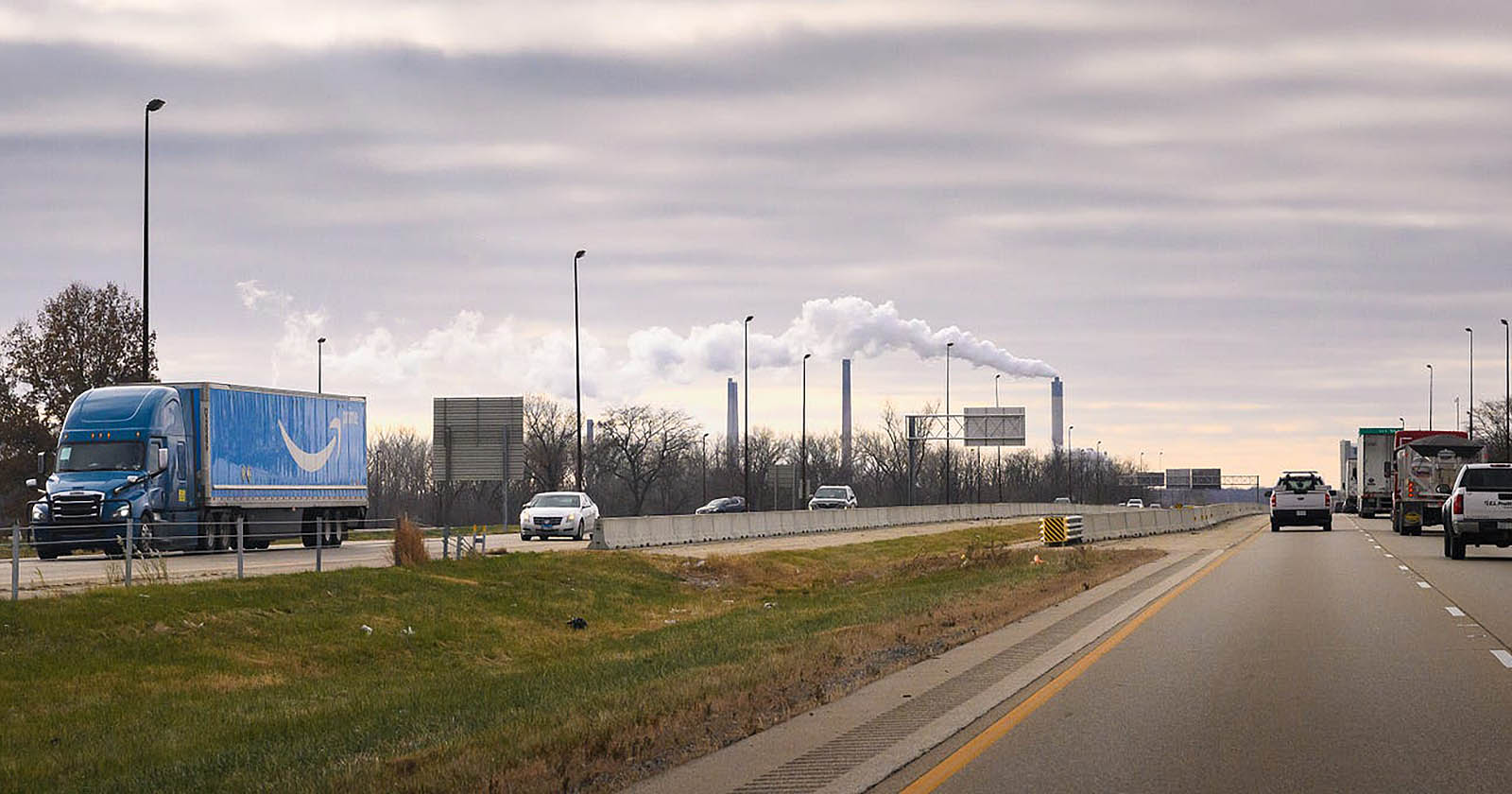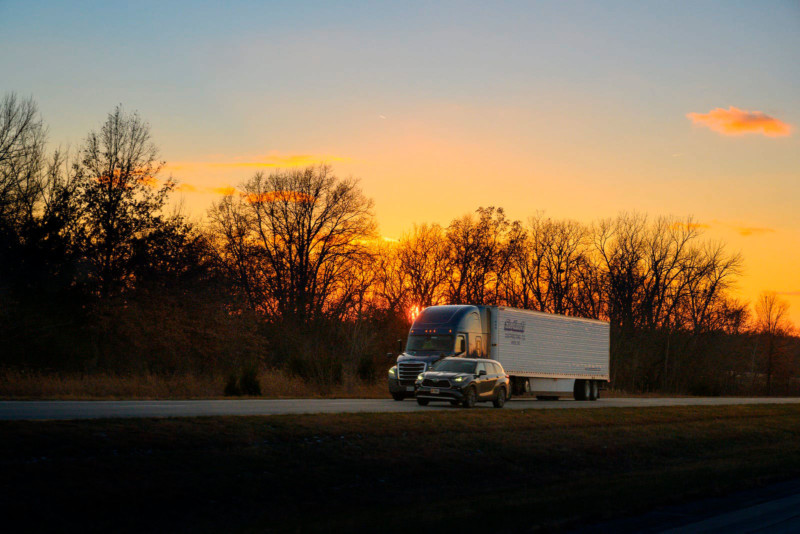
Landscape photography at 70 mph. Is it even possible? For years the idea of landscape photography was to put your camera on a tripod, frame very carefully, then wait for the light to be perfect before you shot. But what if you had to do everything in exactly the opposite way?
Recently I traveled from Chicago to Santa Fe. We had to drive 1,300 miles in four days and that meant we would usually be going about 70 mph. It seemed crazy to me to imagine I could take pictures along the way but just for fun I brought my camera along — and this is what happened next.

We pulled out of Chicago on a grey afternoon, heading west. A few hours later, cruising on Interstate 72, I started paying attention to the scenery passing by. Hmmm, that’s interesting, it was an industrial landscape with trucks, cars, and smokestacks, the ribbon of the road. All of it was sailing by at 70 mph and I was looking at it through the windshield, but nonetheless, I started wondering if there was a way to make pictures of it.
My camera was at my feet – it always is when I’m on the road – so I picked it up and started looking. The first thing I saw was that the long end of the lens was going to be my workhorse so I racked it out to 70mm and started fishing.

Now let’s take a minute here to talk about how impossible this would have been a few years ago, and let’s begin with the limitations of film. The fastest color stock then was ASA 400, and even now it doesn’t get much faster than Portra 800. On the other hand, any modern digital camera will happily give you another stop or two. And that’s important — because I wanted to shoot with a shutter speed of between a 2500th and an 8000th of a second to freeze the moving scenery. I also wanted an iris of at least f/8 to give me the depth of field that the 70mm lens required.
Then the camera needed great stabilization because a camera without it would mess up too many shots. If you ever want to know how much your car shakes as it goes down the road put up a long lens, put your eye in the viewfinder, and try to hold a frame. Even with 5-axis stabilization and careful hand-holding I soon decided to frame a little loose to give myself a chance to perfect the composition after the fact. I figured that as long as the image was crisp I could define the edges later.
And that leads to the last thing, I’ve never been so happy that my camera had a 45-megapixel sensor because I knew I would be throwing away some of its resolution on every shot. So the good news was that I had finally found a situation that would really test every aspect of a modern camera. Then I found out that shooting this way would really test me too.

At 70 miles an hour, you are moving through space at about 102 feet per second, 102.667 if you want a little more precision. A 70mm lens only sees about 28 degrees horizontally on a full-frame body That’s an angle smaller than this < so when you point the lens out the side window the scene rushes by so fast that there is no way you can really see it — at least not the part of the scenery close to the lens. But that’s what the 8000th-second shutter speed is all about. Remember, we are traveling at 102 feet per second but with a shutter speed of 1/8000 the car only moves forward about an inch during the exposure, that’s magic!
Let me show you what I’m talking about. Here’s a frame made looking out the side window as we rolled down the road doing about 70 mph.

You can see from the data that the light has dropped a little because I was shooting in aperture mode and the camera dropped the shutter speed to 1/2500 of a second.
So let’s look at what that did to the picture.

The trees are tack sharp even at 1/2500 because they are hundreds of feet away. The inch or two of forward motion is a tiny fraction of that.

In the foreground though, the field is only 20 or 25 feet from the camera. Here the car’s motion relative to the field becomes visible. Another thing you can see is that the focus is just a tad back from where it should be. Even at an f/8 depth of field, it is on the ragged edge. I might want to shoot at f/11 and bring focus forward a tad next time.
But even with the camera helping you it’s still not easy. You have to size up the scene long before you get to it, make decisions about where the best angle will be, watch the scene coming into frame and getting bigger every second, and oh yeah, try to guess when and where you can shoot to miss the fence posts or other foreground obstacles that keep trying to get between you and your scene. It’s a great dance, one that really sharpens your reflexes after a day or two.

Here’s a picture I chased for a mile or two. It began when I saw that contrail high in the sky and thought it would be great if there was nothing between it and the ground. So I asked my friend David to speed up to get to the place with only a low hill in the distance, then to slow down to hold this changing frame in view as long as he could. I shot four or five pictures in 30 seconds and only this one really came together but I knew it was a keeper even as I was pressing the release. In that way, this is shooting landscapes like you might shoot concerts or sports. You have to go with your gut, trust the world to give you what you need, and act without an instant of hesitation.
So did this plan always work? No of course not. I could easily spend an hour telling you about the pictures I didn’t get. The ones where my camera was on the floor instead of in my hands, or when a car got in my way at the last second, or the times I decided too late that there was a picture hiding just up ahead.
But we don’t live for the pictures we didn’t make, only the ones we did, so here are some landscape pictures made at 70 miles an hour. It is possible — and I had a good time doing it too.
About the author: Andy Romanoff started taking pictures over sixty years ago. He has shot using cameras of every description including box cameras, rangefinders, SLRs, TLRs, view cameras, DSLRs, and movie cameras from Aaton to Panavision. Now he is shooting with a mirrorless camera while he waits for what comes next. He lists his photo sales here and you can subscribe to his YouTube Channel here. This story was also published here.







